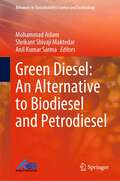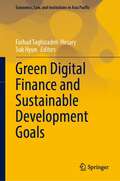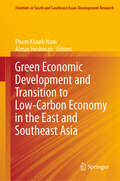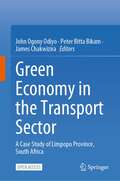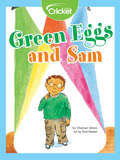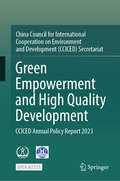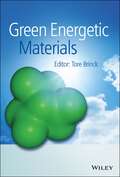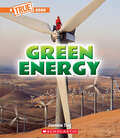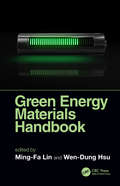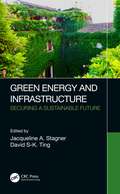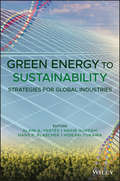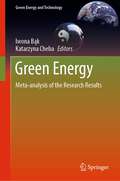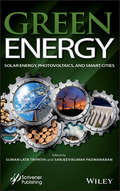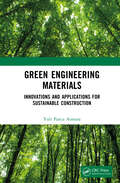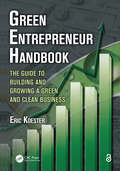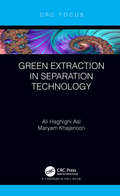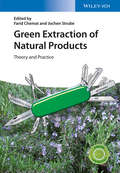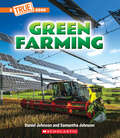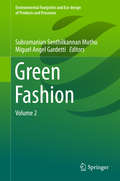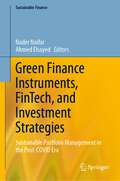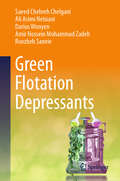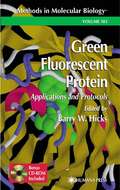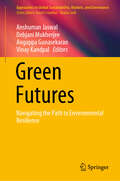- Table View
- List View
Green Diesel: An Alternative to Biodiesel and Petrodiesel (Advances in Sustainability Science and Technology)
by Mohammad Aslam Shrikant Shivaji Maktedar Anil Kumar SarmaThis book covers the entire spectrum of green diesel and their applications in existing CI engines. This book discusses how a green diesel is a better fuel than biodiesel and petrodiesel and more suitable fuels for sustainable future development. The book begins with a concise overview of the fundamentals of the green diesel properties, preparation, and characterization of green diesel using hydroprocessing technology. The book covers recent developments in the domain of green diesel derived particularly from the second-/third-generation feedstocks. Various topics covered in this book include the catalysts involved in the processing of green diesel, characterization of the products as per ASTM/EN protocols. In addition, the book also illustrates characteristic features of green diesel and how it is different from biodiesel and petrodiesel. Other chapters cover performance and emission characteristics of green diesel in CI engines and techno-economic analysis. Moreover, the current status of green diesel industries is also incorporated. This book is of particular interest to graduate students and academic or industrial researchers/professionals working in the area of green diesel/green energy, bioenergy and mechanical, automobile, and chemical engineering. This book makes a forceful foundation for the establishment of green diesel refineries/biorefineries for a sustainable, cleaner, and greener future.
Green Digital Finance and Sustainable Development Goals (Economics, Law, and Institutions in Asia Pacific)
by Farhad Taghizadeh-Hesary Suk HyunThis book aims to fill the literature gap on digital instruments and FinTech in enhancing green finance. Technological innovation can increase transparency, accountability, and speed, decentralize the financial system, improve risk management, increase competition, lower costs, improve efficiency, increase cross-sectoral collaboration and integration, and scale up green finance. Artificial intelligence (AI), distributed ledger technologies (DLT) or blockchain, peer-to-peer lending platforms, big data, Internet-based and mobile-based payment platforms, Internet of Things (IoT), matchmaking platforms including crowdlending, tokenizing green assets are potential means to scale up the green finance for achieving the SDGs. The COVID-19 pandemic, the economic downturns, and the uncertainties shrank the new investments in renewable energy projects globally. Low investment in renewable energy projects could threaten the expansion of green energy needed to provide energy security and meet SDG7 and SDG13. Investments in renewable energy projects are scarce because of several risks and a low rate of return. Although several new green financing solutions such as green bonds, green banks, green credit guarantee, carbon taxation, carbon trade, village funds, and community trust funds have been established in different countries, these are insufficient, and alternative ways to finance projects are required. The book provides several high-quality studies on utilizing digitalization, FinTech, financial innovations, and other new technologies to fill the finance gap of green projects to meet the SDG goals. The chapters are written by scholars in diverse countries and regions and include practical policy recommendations.
Green Economic Development and Transition to Low-Carbon Economy in the East and Southeast Asia (Frontiers in South and Southeast Asian Development Research)
by Almas Heshmati Pham Khanh NamThis edited volume consists of research in three closely related fields: (i) carbon emissions allowance and market, (ii) green economic development and sustainable finance, and (iii) environmental, social, and good governance. The applications are diverse and cover several countries including China, Indonesia, Vietnam, the region of East and Southeast Asia, and its comparison with those practiced in European Union. The green economic development and transition includes studies of the green-oriented economic development and transition from fossil fuel-based brown economy to low-carbon green economy. The volume provides a comprehensive overview of the application of green economic development and transition to low-carbon economy in different parts of the region. Its unique and empirical insights into the up-to-date approaches, laws, and policies enable countries to undertake the transformation to a low-carbon economy possible. The volume offers practitioners a deeper understanding of the green and carbon economy and challenges faced in their implementation. It presents different approaches and practical examples of how to shape environmental policy to successfully implement a green and low-carbon economy at different levels. It provides analysis of development of regulations and integrated environmental policies for a green economy supported by empirical evidence. The countries in the region have invested heavily in development infrastructure and cooperate to develop in an environmentally sustainable way. This edited volume is written by professionals with good insights into the features of the region’s economy and its green development potential.
Green Economy in the Transport Sector: A Case Study of Limpopo Province, South Africa
by John Ogony Odiyo Peter Bitta Bikam James ChakwiziraThis open access book is interdisciplinary and provides cross-sectoral and multi-dimensional exploration of sustainable development and transportation in South Africa. Drawing on work from different disciplines, the book contributes not only to academia but also seeks to inform urban and regional policy with the view of contributing to the national aspirations of South Africa as espoused in the National Development Plan (NDP), 2030, National Spatial Development Framework (NSDF) Draft (2019), National Climate Change Adaptation Strategy (NCASS) Draft (2019), Green Transport Strategy for South Africa (2018–2050), and National Transportation Plan (NATMAP), 2050. Adopting a multi-dimensional assessment, the book provides a background for co-production concerning climate change, sustainable development, and transportation in the Global South. The book contributes in its analysis of the institutional and legislative framework that relates to the climate change, skills and knowledge transfer, sustainable development, and transportation in South Africa, as these are responsible for the evolution of the green economy and transport sector in the country. The connections among different sectors and issues such as environment, transport modes, technology innovation, vehicle management and emission control, skills and knowledge transfer, legislative and policy framework, and the wider objectives of the sustainable development goals (SDGs), especially goals 11 to 13. The success stories relating to climate change, sustainable development, and transportation in South Africa are identified together with the best possible practices that may inform better environmental, urban and regional planning, policy, practice, and management.
Green Eggs and Sam
by Charnan SimonSam's mother shows him how the primary colors of light and the primary colors of pigment are different with a series of ingenious experiments.
Green Empowerment and High Quality Development: CCICED Annual Policy Report 2023
by CCICEDThis open access book records major environmental green development ideas based on mainstream of China&’s policy reform collecting from ten major subjects from all study group. It focuses on the progress of China&’s environment and development policies from 2023&’s study accomplishments. It is mainly a reference of providing environmental policy recommendations for policy makers of China and beyond. In 2024, the world economy is still on the way to recovery. Making peace with nature is the only way to get back on the right track of sustainable development. The year of 2023 also marks an important year for China to implement at its 14th Five-Year Plan. As an annual publication, this book is based on the research outputs of CCICED in 2023. Those researches include carbon neutrality, blue economy, collaborative mechanism, watershed management and climate adaptation, BRI green development, sustainable supply chain, sustainable investment, reshaping land use, and innovative technologies for greenhouse gas, etc.
Green Energetic Materials
by Tore BrinckSince the end of the 20th century it has been increasingly realised that the use, or production, of many energetic materials leads to the release of substances which are harmful to both humans and the environment. To address this, the principles of green chemistry can be applied to the design of new products and their manufacturing processes, to create green energetic materials that are virtually free of environmental hazards and toxicity issues during manufacturing, storage, use and disposal. Active research is underway to develop new ingredients and formulations, green synthetic methods and non-polluting manufacturing processes.Green Energetic Materials provides a detailed account of the most recent research and developments in the field, including green pyrotechnics, explosives and propellants. From theoretical modelling and design of new materials, to the development of sustainable manufacturing processes, this book addresses materials already on the production line, as well as considering future developments in this evolving field.Topics covered include:Theoretical design of green energetic materialsDevelopment of green pyrotechnicsGreen primary and secondary explosivesOxidisers and binder materials for green propellantsEnvironmentally sustainable manufacturing technologies for energetic materialsElectrochemical methods for synthesis of energetic materials and waste remediationGreen Energetic Materials is a valuable resource for academic, industrial and governmental researchers working on the development of energetic materials, for both military and civilian applications.
Green Energy (A True Book (Relaunch))
by Jasmine TingEnvision a brighter future with this STEM-based subset of True Books.We use a lot of energy to power our lives = from our homes and cars to our tablets and handheld games. The challenge facing us today is finding sustainable energy methods that will ensure a green future. There are seven different types of green energy = and they are the only types that don't pollute our Earth. We have learned how to harness the power of the sun, wind, water, and Earth. And technological innovations have allowed us to put these alternative energies to work in our everyday lives. Green Energy will show you how.ABOUT THE SERIES:What would a green future look like? Will trains and airplanes be powered by the sun? Will we have homes that have zero impact on the environment? The most pressing challenge facing us today is how to ensure a healthy Earth for ourselves and future generations. This STEM-based set of A True Books introduces students to the engineering innovations that can help us reach those goals. Interesting information is presented in a fun, friendly way = and in the simplest terms possible = and will inspire kids to start envisioning and enacting a more sustainable future.
Green Energy Materials Handbook
by Ming-Fa Lin Wen-Dung HsuGreen Energy Materials Handbook gives a systematic review of the development of reliable, low-cost, and high-performance green energy materials, covering mainstream computational and experimental studies as well as comprehensive literature on green energy materials, computational methods, experimental fabrication and characterization techniques, and recent progress in the field. <P><P> This work presents complete experimental measurements and computational results as well as potential applications. Among green technologies, electrochemical and energy storage technologies are considered as the most practicable, environmentally friendly, and workable to make full use of renewable energy sources. This text includes 11 chapters on the field, devoted to 4 important topical areas: computational material design, energy conversion, ion transport, and electrode materials. <P><P> This handbook is aimed at engineers, researchers, and those who work in the fields of materials science, chemistry, and physics. The systematic studies proposed in this book can greatly promote the basic and applied sciences.
Green Energy and Infrastructure: Securing a Sustainable Future
by Jacqueline A. StagnerC. S. Lewis rightly instructed, "The task of the modern educator is not to cut down jungles, but to irrigate deserts." This book aims to achieve this task by pushing the frontiers of scholarship for securing a sustainable future through green energy and infrastructure. This encompasses the notion that what we create is in harmony and integration with both the spatial and temporal domains. Through numerous practical examples and illustrations, this book examines a comprehensive review of the latest science on indoor environmental health, energy requirements for buildings, and the "greening" of infrastructure. Also, it provides a discussion on the underlying properties of biomass and its influence on furthering energy conversion technologies. Energy storage is essential for driving the integration of renewable energy, and different storage approaches are discussed in terms of power balancing, grid stability, and reliability. Features: Focuses on the importance of coupling green energy with green infrastructure Provides an unbiased update of the state-of-the-art of sustainability science Discusses utilizing sustainable building materials for simultaneous improvement in energy, economic, and environmental bottom lines for industry Illuminates practical steps that need to be undertaken to achieve a greener infrastructure Green Energy and Infrastructure: Securing a Sustainable Future is appropriate for researchers, students, and decision-makers seeking the latest, practical information on environmental sustainability.
Green Energy to Sustainability: Strategies for Global Industries
by S Alain A. Vert 232Reviews the latest advances in biofuel manufacturing technologies and discusses the deployment of other renewable energy for transportation Aimed at providing an interface useful to business and scientific managers, this book focuses on the key challenges that still impede the realization of the billion-ton renewable fuels vision. It places great emphasis on a global view of the topic, reviewing deployment and green energy technology in different countries across Africa, Asia, South America, the EU, and the USA. It also integrates scientific, technological, and business development perspectives to highlight the key developments that are necessary for the global replacement of fossil fuels with green energy solutions. Green Energy to Sustainability: Strategies for Global Industries examines the most recent developments in biofuel manufacturing technologies in light of business, financial, value chain, and supply chain concerns. It also covers the use of other renewable energy sources like solar energy for transportation and proposes a view of the challenges over the next two to five decades, and how these will deeply modify the industrial world in the third millennium. The coming of age of electric vehicles is also looked at, as is the impact of their deployment on the biomass to biofuels value chain. Offers extensive updates on the field of green energy for global industries Covers the structure of the energy business; chemicals and diesel from biomass; ethanol and butanol; hydrogen and methane; and more Provides an expanded focus on the next generation of energy technologies Reviews the latest advances in biofuel manufacturing technologies Integrates scientific, technological and business perspectives Highlights important developments needed for replacing fossil fuels with green energy Green Energy to Sustainability: Strategies for Global Industries will appeal to academic researchers working on the production of fuels from renewable feedstocks and those working in green and sustainable chemistry, and chemical/process engineering. It is also an excellent textbook for courses in bioprocessing technology, renewable resources, green energy, and sustainable chemistry.
Green Energy: Meta-analysis of the Research Results (Green Energy and Technology)
by Iwona Bąk Katarzyna ChebaThis book presents novel research that represents a multidimensional approach to green energy. Each chapter addresses its subject from diverse perspectives, including financial, technological, and social. The results shown also consider various approaches to the collection and processing of data on green energy. The book also reports on analyses of data from official records and databases, as well as the analysis of primary data obtained directly. The book will be of interest to those working in green energy as well as researchers interested in the methods of scientific research.
Green Energy: Solar Energy, Photovoltaics, and Smart Cities (Green Energy And Technology Ser.)
by Suman Lata Tripathi Sanjeevikumar PadmanabanLike most industries around the world, the energy industry has also made, and continues to make, a long march toward “green” energy. The science has come a long way since the 1970s, and renewable energy and other green technologies are becoming more and more common, replacing fossil fuels. It is, however, still a struggle, both in terms of energy sources keeping up with demand, and the development of useful technologies in this area. To maintain the supply for electrical energy, researchers, engineers and other professionals in industry are continuously exploring new eco-friendly energy technologies and power electronics, such as solar, wind, tidal, wave, bioenergy, and fuel cells. These technologies have changed the concepts of thermal, hydro and nuclear energy resources by the adaption of power electronics advancement and revolutionary development in lower manufacturing cost for semiconductors with long time reliability. The latest developments in renewable resources have proved their potential to boost the economy of any country. Green energy technology has not only proved the concept of clean energy but also reduces the dependencies on fossil fuel for electricity generation through smart power electronics integration. Also, endless resources have more potential to cope with the requirements of smart building and smart city concepts. A valuable reference for engineers, scientists, chemists, and students, this volume is applicable to many different fields, across many different industries, at all levels. It is a must-have for any library.
Green Energy: Sustainable Electricity Supply with Low Environmental Impact
by Eric JeffsGreen Energy: Sustainable Electricity Supply with Low Environmental Impact defines the future of the world’s electricity supply system, exploring the key issues associated with global warming, and which energy systems are best suited to reducing it. Electricity generation is a concentrated industry with a few sources of emissions, which can be controlled or legislated against. This book explains that a green sustainable electricity system is one whose construction, installation, and operation minimally affect the environment and produce power reliability at an affordable price. It addresses the question of how to build such an electricity supply system to meet the demands of a growing population without accelerating global warming or damaging the environment. The green argument for conservation and renewable energies is a contradiction in terms. Although they produce no emissions, because renewable systems are composed of a large number of small units, a considerable amount of energy is required to produce, erect, and maintain them. This book is a response to that conundrum, answering key questions, such as: How can renewables be exploited to contribute the greatest energy input? Should coal be used for clean fuel and chemical production rather than for power generation? How quickly can we start to build the Green Energy system? The author has more than forty years of experience as an international journalist reporting on power-generating technologies and on energy policies around the world. Detailing the developmental history, and current state, of the global nuclear industry, he discusses the dire, immediate need for large quantities of clean, emission-free electric power, for both domestic and industrial uses. This book details how current technologies—particularly nuclear, combined cycle, and hydro—can be applied to satisfy safely the growing energy demands in the future.
Green Engineering Materials: Innovations and Applications for Sustainable Construction
by Yuli Panca AsmaraThe use of green engineering materials represents a promising approach to sustainable development. This book explores various renewable materials and their properties, applications, and technological advancements driving their use in modern engineering and construction. This book highlights the significance of green engineering materials in sustainable development and explains their effective use in engineering and construction. It covers bamboo as a rapidly growing renewable material in use with significant engineering potential, detailing its unique characteristics, preservation methods, and uses in construction. The book also investigates sustainable plant-based composites, focusing on biopolymer and biomass matrices, cellulose-based materials, lignin, polylactic acid, and natural rubber. It highlights the benefits of plant fibres like rice husk ash and jute while addressing the challenges in adopting these composites in engineering. Green concrete technologies like hybrid geopolymers and green additives and their manufacturing processes are also discussed. Following this, the book discusses bio-based adhesives and then explores the industrial potential of rice husk ash in applications including electronic devices, composites, and reinforced concrete. Palm oil and coconut shells are also examined as versatile renewable resources for various construction and development applications. Finally, the book emphasizes the importance of wood in construction, including its properties, treatment methods, and future trends in sustainable construction practices. Because this has a broad scope and provides readers with a basic level of technical knowledge, it is an ideal guide for general readers concerned with sustainability as well as anyone starting out in the field, including undergraduate students and readers in the industry who want to keep abreast of current developments and trends in this field.
Green Entrepreneur Handbook: The Guide to Building and Growing a Green and Clean Business (What Every Engineer Should Know Ser.)
by Eric KoesterWritten by a practicing business attorney with startup experience in the environmental and technology sectors, this comprehensive handbook assists entrepreneurs in tackling the wide variety of opportunities to go green. A one-stop resource for entrepreneurs, it helps readers incorporate clean technology, environmental practices, and green business approaches into the work environment. The book discusses how to sell to utilities, explores fundraising outlets for green businesses, covers government incentives, presents key startup tools aimed at green businesses, and addresses challenges of many new businesses, such as raising money and making sales. Additional resources are available on the book's website.
Green Equilibrium: Deciphering Earth's Ecosystems for Sustainable Tomorrow (Green Energy and Technology)
by Akarsh Verma Juhi GuptaThis book offers a profound exploration into our planet's intricate ecosystems, highlighting the urgent need for sustainable practices. Through insightful analysis and compelling narratives, this book unveils the delicate balance of nature and our role in preserving it for future generations. This book is a must-read for those committed to understanding and protecting our Earth's environmental harmony. Join the journey toward a sustainable tomorrow.
Green Extraction in Separation Technology
by Ali Haghighi Asl Maryam KhajenooriSubcritical water is a green extraction solvent compared to conventional extraction solvents. While experimental results on subcritical water extraction (SWE) technology have been published piecemeal, there has been no comprehensive review of the state of the art. Green Extraction in Separation Technology fills that gap, serving to cover extracting with subcritical water as an environmentally friendly solvent. FEATURES Presents new technologies for extracting natural compounds from plants and compares the advantages and disadvantages versus SWE Explains research on SWE over the last 15 years Offers an overview of the solubility of different compounds in SWE and related theoretical content Discusses modeling of SWE and describes the development of a new model for this process This monograph is aimed at researchers and advanced students in chemical and biochemical engineering.
Green Extraction of Natural Products: Theory and Practice
by Farid Chemat Jochen StrubeExtraction processes are essential steps in numerous industrial applications from perfume over pharmaceutical to fine chemical industry. Nowadays, there are three key aspects in industrial extraction processes: economy and quality, as well as environmental considerations. This book presents a complete picture of current knowledge on green extraction in terms of innovative processes, original methods, alternative solvents and safe products, and provides the necessary theoretical background as well as industrial application examples and environmental impacts. Each chapter is written by experts in the field and the strong focus on green chemistry throughout the book makes this book a unique reference source. This book is intended to be a first step towards a future cooperation in a new extraction of natural products, built to improve both fundamental and green parameters of the techniques and to increase the amount of extracts obtained from renewable resources with a minimum consumption of energy and solvents, and the maximum safety for operators and the environment.
Green Farming (A True Book (Relaunch))
by Daniel Johnson Priyanka LamichhaneEnvision a brighter future with this STEM-based subset of True Books.Thanks to the development of agriculture, our Earth can feed the almost 8 billion people that call it home. But the challenge facing us today is how to make the practice of large-scale farming sustainable. We have learned how to use alternative energies = like solar and wind power = to run our farms. We have also learned how to use the land and the animals on it in a more environmentally friendly way. Green Farming will show you how.ABOUT THE SERIES:What would a green future look like? Will trains and airplanes be powered by the sun? Will we have homes that have zero impact on the environment? The most pressing challenge facing us today is how to ensure a healthy Earth for ourselves and future generations. This STEM-based set of A True Books introduces students to the engineering innovations that can help us reach those goals. Interesting information is presented in a fun, friendly way = and in the simplest terms possible = and will inspire kids to start envisioning and enacting a more sustainable future.
Green Fashion: Volume 2 (Environmental Footprints And Eco-design Of Products And Processes)
by Subramanian Senthilkannan Muthu Miguel Angel GardettiThis book details the crux of green fashion, addressing various environmental aspects and discussing the importance of sustainable fashion in the apparel industry. It addresses various important topics such as Relationship marketing in green fashion, Animal Ethics and Welfare in the Fashion and Lifestyle Industries, Green Flame retardants, etc.
Green Finance Instruments, FinTech, and Investment Strategies: Sustainable Portfolio Management in the Post-COVID Era (Sustainable Finance)
by Ahmed Elsayed Nader NaifarIn the COVID 19 post-pandemic era, sustainable financial systems are increasingly getting the attention they deserve, and policymakers are now moving toward investment and financing decisions based on sustainable development. Green finance plays an important role in mobilizing financial resources and hedging against environmental risk to achieve financially sustainable systems. Moreover, green financial instruments offer viable alternatives for investors and regulators with regard to portfolio management and risk minimization. Over the last few years, financial technology (FinTech) has grown to become one of the most topical areas in the global financial services industry. The development of distributed ledger technology, big data, smart contracts, peer-to-peer lending platforms, biometrics, and new digital has sparked innovation in the financial services industry and the development of new financing and investment strategies. The combination of sustainability and FinTech can help policymakers to achieve ESG targets when making investment and financing decisions. This book showcases a collection of recent advances in green finance and FinTech and explores their impact in achieving sustainable finance, investment strategy-making, and portfolio management. Presenting theoretical frameworks and the latest empirical studies in the field of green finance and FinTech, it offers a valuable asset for academics, professionals, policymakers, regulators, and investors who want to understand in-depth the impact of green finance and FinTech on future investment and financing strategies in the post-pandemic era.
Green Flotation Depressants
by Saeed Chehreh Chelgani Ali Asimi Neisiani Darius Wonyen Amir Hossein Mohammad Zadeh Roozbeh SaneieThis book presents biodegradable depressants, delving deep into their performance, intricate structures, and adsorption mechanisms. The book presents diverse minerals and materials where these depressants have been used for their upgrading. Encompassing the entirety of current research, it is an indispensable read for both industry professionals and researchers in the field, especially on courses centered around froth flotation and recycling. From the starch-based solutions in Chapter 1 to the diverse array of gums explored in Chapters 7 to 10, and the intriguing polyaspartate and tripolyphosphate in Chapters 11 and 12 respectively, each section unfolds a rich tapestry of knowledge, providing a holistic understanding of biodegradable depressants and their pivotal role in mineral processing.
Green Fluorescent Protein
by Barry W. HicksBarry W. Hicks and a team of well-practiced experimentalists demonstrate the power and the versatility of the green fluorescent protein (GFP) marker with a cutting-edge collection of readily reproducible GFP techniques. These include methods for detecting and imaging GFP (FRET, BRET, and whole-body imaging); for using GFP to create and select for transgenic organisms, for its use as a biosensor; and for studying viruses.
Green Futures: Navigating the Path to Environmental Resilience (Approaches to Global Sustainability, Markets, and Governance)
by Angappa Gunasekaran Debjani Mukherjee Vinay Kandpal Anshuman JaswalThis book presents a comprehensive examination of the complex journey toward achieving environmental resilience in the twenty-first century. It brings together leading voices from various fields to showcase the challenges and promising solutions in sustainability and green futures. Organized into thematic divisions, each chapter presents a different facet of environmental resilience, offering incisive analysis, creative techniques, and case studies from around the globe. The book explores the complex intersections of environmental, social, and economic elements, including climate change mitigation and adaptation, sustainable urban development, biodiversity conservation, and renewable energy technology. Contributions from distinguished scholars, policymakers, activists, and practitioners encourage interdisciplinary discourse and collaboration to address urgent environmental challenges. The book inspires readers to envision and actively contribute to a more sustainable and resilient future through rigorous research, visionary thinking, and practical ideas. Combining intellectual rigor with approachable prose, this book serves as an invaluable resource for students, scholars, policymakers, and anyone committed to creating a greener and more resilient society. It provides vital information and inspiration for navigating the path toward environmental resilience, whether dealing with the complexity of climate change, seeking innovative solutions for sustainable development, or advocating for environmental justice.
